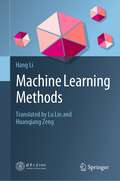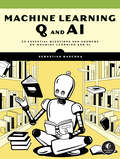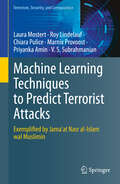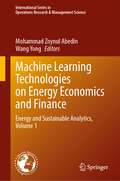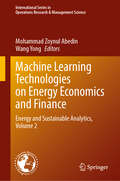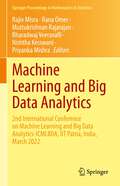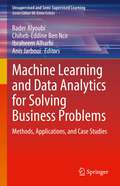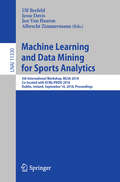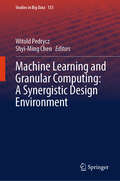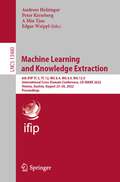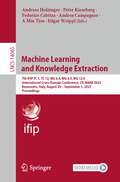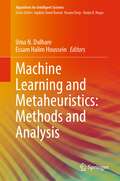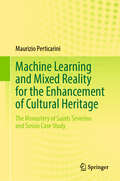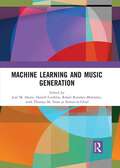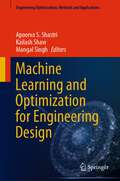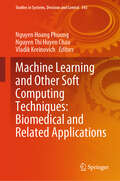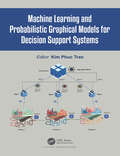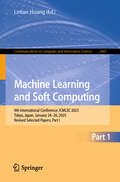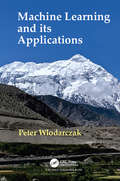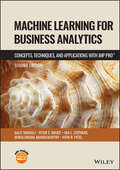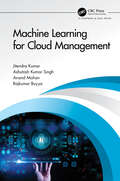- Table View
- List View
Machine Learning Meets Quantum Physics (Lecture Notes in Physics #968)
by Klaus-Robert Müller Kristof T. Schütt Stefan Chmiela O. Anatole von Lilienfeld Alexandre Tkatchenko Koji TsudaDesigning molecules and materials with desired properties is an important prerequisite for advancing technology in our modern societies. This requires both the ability to calculate accurate microscopic properties, such as energies, forces and electrostatic multipoles of specific configurations, as well as efficient sampling of potential energy surfaces to obtain corresponding macroscopic properties. Tools that can provide this are accurate first-principles calculations rooted in quantum mechanics, and statistical mechanics, respectively. Unfortunately, they come at a high computational cost that prohibits calculations for large systems and long time-scales, thus presenting a severe bottleneck both for searching the vast chemical compound space and the stupendously many dynamical configurations that a molecule can assume. To overcome this challenge, recently there have been increased efforts to accelerate quantum simulations with machine learning (ML). This emerging interdisciplinary community encompasses chemists, material scientists, physicists, mathematicians and computer scientists, joining forces to contribute to the exciting hot topic of progressing machine learning and AI for molecules and materials. The book that has emerged from a series of workshops provides a snapshot of this rapidly developing field. It contains tutorial material explaining the relevant foundations needed in chemistry, physics as well as machine learning to give an easy starting point for interested readers. In addition, a number of research papers defining the current state-of-the-art are included. The book has five parts (Fundamentals, Incorporating Prior Knowledge, Deep Learning of Atomistic Representations, Atomistic Simulations and Discovery and Design), each prefaced by editorial commentary that puts the respective parts into a broader scientific context.
Machine Learning Methods
by Hang LiThis book provides a comprehensive and systematic introduction to the principal machine learning methods, covering both supervised and unsupervised learning methods. It discusses essential methods of classification and regression in supervised learning, such as decision trees, perceptrons, support vector machines, maximum entropy models, logistic regression models and multiclass classification, as well as methods applied in supervised learning, like the hidden Markov model and conditional random fields. In the context of unsupervised learning, it examines clustering and other problems as well as methods such as singular value decomposition, principal component analysis and latent semantic analysis. As a fundamental book on machine learning, it addresses the needs of researchers and students who apply machine learning as an important tool in their research, especially those in fields such as information retrieval, natural language processing and text data mining. In order to understand the concepts and methods discussed, readers are expected to have an elementary knowledge of advanced mathematics, linear algebra and probability statistics. The detailed explanations of basic principles, underlying concepts and algorithms enable readers to grasp basic techniques, while the rigorous mathematical derivations and specific examples included offer valuable insights into machine learning.
Machine Learning Q and AI: 30 Essential Questions and Answers on Machine Learning and AI
by Sebastian RaschkaLearn the answers to 30 cutting-edge questions in machine learning and AI and level up your expertise in the field.If you&’re ready to venture beyond introductory concepts and dig deeper into machine learning, deep learning, and AI, the question-and-answer format of Machine Learning Q and AI will make things fast and easy for you, without a lot of mucking about.Born out of questions often fielded by author Sebastian Raschka, the direct, no-nonsense approach of this book makes advanced topics more accessible and genuinely engaging. Each brief, self-contained chapter journeys through a fundamental question in AI, unraveling it with clear explanations, diagrams, and hands-on exercises.WHAT'S INSIDE:FOCUSED CHAPTERS: Key questions in AI are answered concisely, and complex ideas are broken down into easily digestible parts.WIDE RANGE OF TOPICS: Raschka covers topics ranging from neural network architectures and model evaluation to computer vision and natural language processing.PRACTICAL APPLICATIONS: Learn techniques for enhancing model performance, fine-tuning large models, and more.You&’ll also explore how to:• Manage the various sources of randomness in neural network training• Differentiate between encoder and decoder architectures in large language models• Reduce overfitting through data and model modifications• Construct confidence intervals for classifiers and optimize models with limited labeled data• Choose between different multi-GPU training paradigms and different types of generative AI models• Understand performance metrics for natural language processing• Make sense of the inductive biases in vision transformersIf you&’ve been on the hunt for the perfect resource to elevate your understanding of machine learning, Machine Learning Q and AI will make it easy for you to painlessly advance your knowledge beyond the basics.
Machine Learning Risk Assessments in Criminal Justice Settings
by Richard BerkThis book puts in one place and in accessible form Richard Berk’s most recent work on forecasts of re-offending by individuals already in criminal justice custody. Using machine learning statistical procedures trained on very large datasets, an explicit introduction of the relative costs of forecasting errors as the forecasts are constructed, and an emphasis on maximizing forecasting accuracy, the author shows how his decades of research on the topic improves forecasts of risk. Criminal justice risk forecasts anticipate the future behavior of specified individuals, rather than “predictive policing” for locations in time and space, which is a very different enterprise that uses different data different data analysis tools. The audience for this book includes graduate students and researchers in the social sciences, and data analysts in criminal justice agencies. Formal mathematics is used only as necessary or in concert with more intuitive explanations.
Machine Learning Techniques to Predict Terrorist Attacks: Exemplified by Jama'at Nasr al-Islam wal Muslimin (Terrorism, Security, and Computation)
by Roy Lindelauf V.S. Subrahmanian Chiara Pulice Laura Mostert Marnix Provoost Priyanka AminOne of the most influential actors in spreading Islamist violence across the Sahel is Jama&’at Nasr Al Islam Wal Muslimin (JNIM).This book provides the first systematic quantitative analysis of JNIM&’s behavior by analyzing a 12-year database of JNIM&’s attacks and the environment surrounding JNIM. This book leverages AI/ML predictive models to accurately predict almost 40 types of attacks using over 80 independent variables. This book describes a set of temporal probabilistic rules that state that when the environment in which the group operates satisfies some conditions, then an attack of a certain type will likely occur in the next N months. This provides a deep, easy to comprehend understanding of the conditions under which JNIM carries various kinds of attacks up to 6 months into the future. This book will serve as an invaluable guide to scholars (computer scientists, political scientists, policy makers). Military officers, intelligence personnel, and government employees, who seek to understand, predict, and eventually mitigate attacks by JNIM and bring peace to the nations of Mali, Burkina Faso, and Niger will want to purchase this book as well.
Machine Learning Technologies on Energy Economics and Finance: Energy and Sustainable Analytics, Volume 1 (International Series in Operations Research & Management Science #367)
by Mohammad Zoynul Abedin Wang YongThis book explores the latest innovations in energy economics and finance, with a particular focus on the role of machine learning algorithms in advancing the energy sector. It examines key factors shaping this field, including market structures, regulatory frameworks, environmental impacts, and the dynamics of the global energy market. It discusses the critical application of machine learning (ML) in energy financing, introducing predictive tools for forecasting energy prices across various sectors—such as crude oil, electricity, fuelwood, solar, and natural gas. It also addresses how ML can predict investor behavior and assess the efficiency of energy markets, with a focus on both the opportunities and challenges in renewable energy and energy finance. This book serves as a comprehensive guide for academics, practitioners, financial managers, stakeholders, government officials, and policymakers who seek strategies to enhance energy systems, reduce costs and uncertainties, and optimize revenue for economic growth. This is the first volume of a two-volume set.
Machine Learning Technologies on Energy Economics and Finance: Energy and Sustainable Analytics, Volume 2 (International Series in Operations Research & Management Science #368)
by Mohammad Zoynul Abedin Wang YongThis book explores the latest innovations in energy economics and finance, with a particular focus on the role of machine learning algorithms in advancing the energy sector. It examines key factors shaping this field, including market structures, regulatory frameworks, environmental impacts, and the dynamics of the global energy market. It discusses the critical application of machine learning (ML) in energy financing, introducing predictive tools for forecasting energy prices across various sectors—such as crude oil, electricity, fuelwood, solar, and natural gas. It also addresses how ML can predict investor behavior and assess the efficiency of energy markets, with a focus on both the opportunities and challenges in renewable energy and energy finance. This book serves as a comprehensive guide for academics, practitioners, financial managers, stakeholders, government officials, and policymakers who seek strategies to enhance energy systems, reduce costs and uncertainties, and optimize revenue for economic growth. This is the second volume of a two-volume set.
Machine Learning and Big Data Analytics: 2nd International Conference on Machine Learning and Big Data Analytics-ICMLBDA, IIT Patna, India, March 2022 (Springer Proceedings in Mathematics & Statistics #401)
by Bharadwaj Veeravalli Rajiv Misra Muttukrishnan Rajarajan Nishtha Kesswani Rana Omer Priyanka MishraThis edited volume on machine learning and big data analytics (Proceedings of ICMLBDA 2022) is intended to be used as a reference book for researchers and professionals to share their research and reports of new technologies and applications in Machine Learning and Big Data Analytics like biometric Recognition Systems, medical diagnosis, industries, telecommunications, AI Petri Nets Model-Based Diagnosis, gaming, stock trading, Intelligent Aerospace Systems, robot control, law, remote sensing and scientific discovery agents and multiagent systems; and natural language and Web intelligence. The intent of this book is to provide awareness of algorithms used for machine learning and big data in the advanced Scientific Technologies, provide a correlation of multidisciplinary areas and become a point of great interest for Data Scientists, systems architects, developers, new researchers and graduate level students. This volume provides cutting-edge research from around the globe on this field. Current status, trends, future directions, opportunities, etc. are discussed, making it friendly for beginners and young researchers.
Machine Learning and Data Analytics for Solving Business Problems: Methods, Applications, and Case Studies (Unsupervised and Semi-Supervised Learning)
by Bader Alyoubi Chiheb-Eddine Ben Ncir Ibraheem Alharbi Anis JarbouiThis book presents advances in business computing and data analytics by discussing recent and innovative machine learning methods that have been designed to support decision-making processes. These methods form the theoretical foundations of intelligent management systems, which allows for companies to understand the market environment, to improve the analysis of customer needs, to propose creative personalization of contents, and to design more effective business strategies, products, and services. This book gives an overview of recent methods – such as blockchain, big data, artificial intelligence, and cloud computing – so readers can rapidly explore them and their applications to solve common business challenges. The book aims to empower readers to leverage and develop creative supervised and unsupervised methods to solve business decision-making problems.
Machine Learning and Data Mining for Sports Analytics: 5th International Workshop, MLSA 2018, Co-located with ECML/PKDD 2018, Dublin, Ireland, September 10, 2018, Proceedings (Lecture Notes in Computer Science #11330)
by Jesse Davis Ulf Brefeld Jan Van Haaren Albrecht ZimmermannThis book constitutes the refereed post-conference proceedings of the 5th International Workshop on Machine Learning and Data Mining for Sports Analytics, MLSA 2018, colocated with ECML/PKDD 2018, in Dublin, Ireland, in September 2018.The 12 full papers presented together with 4 challenge papers were carefully reviewed and selected from 24 submissions. The papers present a variety of topics, covering the team sports American football, basketball, ice hockey, and soccer, as well as the individual sports cycling and martial arts. In addition, four challenge papers are included, reporting on how to predict pass receivers in soccer.
Machine Learning and Granular Computing: A Synergistic Design Environment (Studies in Big Data #155)
by Witold Pedrycz Shyi-Ming ChenThis volume provides the reader with a comprehensive and up-to-date treatise positioned at the junction of the areas of Machine Learning (ML) and Granular Computing (GrC). ML offers a wealth of architectures and learning methods. Granular Computing addresses useful aspects of abstraction and knowledge representation that are of importance in the advanced design of ML architectures. In unison, ML and GrC support advances of the fundamental learning paradigm. As built upon synergy, this unified environment focuses on a spectrum of methodological and algorithmic issues, discusses implementations and elaborates on applications. The chapters bring forward recent developments showing ways of designing synergistic and coherently structured ML-GrC environment. The book will be of interest to a broad audience including researchers and practitioners active in the area of ML or GrC and interested in following its timely trends and new pursuits.
Machine Learning and Knowledge Discovery in Databases: European Conference, ECML PKDD 2022, Grenoble, France, September 19–23, 2022, Proceedings, Part II (Lecture Notes in Computer Science #13714)
by Massih-Reza Amini Petra Kralj Novak Grigorios Tsoumakas Stéphane Canu Asja Fischer Tias GunsThe multi-volume set LNAI 13713 until 13718 constitutes the refereed proceedings of the European Conference on Machine Learning and Knowledge Discovery in Databases, ECML PKDD 2022, which took place in Grenoble, France, in September 2022.The 236 full papers presented in these proceedings were carefully reviewed and selected from a total of 1060 submissions. In addition, the proceedings include 17 Demo Track contributions. The volumes are organized in topical sections as follows: Part I: Clustering and dimensionality reduction; anomaly detection; interpretability and explainability; ranking and recommender systems; transfer and multitask learning; Part II: Networks and graphs; knowledge graphs; social network analysis; graph neural networks; natural language processing and text mining; conversational systems; Part III: Deep learning; robust and adversarial machine learning; generative models; computer vision; meta-learning, neural architecture search; Part IV: Reinforcement learning; multi-agent reinforcement learning; bandits and online learning; active and semi-supervised learning; private and federated learning; . Part V: Supervised learning; probabilistic inference; optimal transport; optimization; quantum, hardware; sustainability; Part VI: Time series; financial machine learning; applications; applications: transportation; demo track.
Machine Learning and Knowledge Extraction: 6th IFIP TC 5, TC 12, WG 8.4, WG 8.9, WG 12.9 International Cross-Domain Conference, CD-MAKE 2022, Vienna, Austria, August 23–26, 2022, Proceedings (Lecture Notes in Computer Science #13480)
by Andreas Holzinger Edgar Weippl A Min Tjoa Peter KiesebergThis book constitutes the refereed proceedings of the 6th IFIP TC 5, TC 12, WG 8.4, WG 8.9, WG 12.9 International Cross-Domain Conference, CD-MAKE 2022, held in Vienna, Austria during August 2022.The 23 full papers presented were carefully reviewed and selected from 45 submissions. The papers are covering a wide range from integrative machine learning approach, considering the importance of data science and visualization for the algorithmic pipeline with a strong emphasis on privacy, data protection, safety and security.
Machine Learning and Knowledge Extraction: 7th IFIP TC 5, TC 12, WG 8.4, WG 8.9, WG 12.9 International Cross-Domain Conference, CD-MAKE 2023, Benevento, Italy, August 29 – September 1, 2023, Proceedings (Lecture Notes in Computer Science #14065)
by Andreas Holzinger Edgar Weippl A Min Tjoa Peter Kieseberg Federico Cabitza Andrea CampagnerThis volume LNCS-IFIP constitutes the refereed proceedings of the 7th IFIP TC 5, TC 12, WG 8.4, WG 8.9, WG 12.9 International Cross-Domain Conference, CD-MAKE 2023 in Benevento, Italy, during August 28 – September 1, 2023. The 18 full papers presented together were carefully reviewed and selected from 30 submissions. The conference focuses on integrative machine learning approach, considering the importance of data science and visualization for the algorithmic pipeline with a strong emphasis on privacy, data protection, safety and security.
Machine Learning and Metaheuristics: Methods and Analysis (Algorithms for Intelligent Systems)
by Uma N. Dulhare Essam Halim HousseinThis book takes a balanced approach between theoretical understanding and real-time applications. All the topics included real-world problems which show how to explore, build, evaluate, and optimize machine learning models fusion with metaheuristic algorithms. Optimization algorithms classified into two broad categories as deterministic and probabilistic algorithms. The content of book elaborates optimization algorithms such as particle swarm optimization, ant colony optimization, whale search algorithm, and cuckoo search algorithm.
Machine Learning and Mixed Reality for the Enhancement of Cultural Heritage: The Monastery of Saints Severino and Sossio Case Study
by Maurizio PerticariniThis book addresses the role of modern surveying and representation technologies in preserving and disseminating cultural heritage. A workflow is illustrated, describing the Former Monastery of Ss Severino and Sossio case study, currently the headquarters of the State Archives of Naples, Italy. After offering a historical overview, the work examines the spaces and structure of the building. A methodology for three-dimensional restitution is presented, using low-cost image-based and professional range-based surveying, concluding with recent AI technologies such as NeRF. The research continues with the virtual and augmented restitution of parts of the building that have been modified, lost over the centuries, or are no longer accessible. The Atrio dei Marmi, the Atrio del Platano, and the Sala del Capitolo and Sala del Refettorio are some of the places where the research has focused, creating a BIM model, using AR for precise interventions, and developing an immersive applied game to understand the third level of the monastery, rich in works of art and today also serving as a museum. In the final chapters, a particular focus is placed on the future of representation: new techniques, ongoing developments in AI supporting surveying, and the new possibilities offered by virtual spaces.
Machine Learning and Music Generation
by José M. Iñesta, Darrell Conklin, Rafael Ramírez-Melendez, with Thomas M. Fiore as Editor-in-ChiefComputational approaches to music composition and style imitation have engaged musicians, music scholars, and computer scientists since the early days of computing. Music generation research has generally employed one of two strategies: knowledge-based methods that model style through explicitly formalized rules, and data mining methods that apply machine learning to induce statistical models of musical style. The five chapters in this book illustrate the range of tasks and design choices in current music generation research applying machine learning techniques and highlighting recurring research issues such as training data, music representation, candidate generation, and evaluation. The contributions focus on different aspects of modeling and generating music, including melody, chord sequences, ornamentation, and dynamics. Models are induced from audio data or symbolic data. This book was originally published as a special issue of the Journal of Mathematics and Music.
Machine Learning and Optimization for Engineering Design (Engineering Optimization: Methods and Applications)
by Apoorva S. Shastri Mangal Singh Kailash ShawThis book aims to provide a collection of state-of-the-art scientific and technical research papers related to machine learning-based algorithms in the field of optimization and engineering design. The theoretical and practical development for numerous engineering applications such as smart homes, ICT-based irrigation systems, academic success prediction, future agro-industry for crop production, disease classification in plants, dental problems and solutions, loan eligibility processing, etc., and their implementation with several case studies and literature reviews are included as self-contained chapters. Additionally, the book intends to highlight the importance of study and effectiveness in addressing the time and space complexity of problems and enhancing accuracy, analysis, and validations for different practical applications by acknowledging the state-of-the-art literature survey. The book targets a larger audience by exploring multidisciplinary research directions such as computer vision, machine learning, artificial intelligence, modified/newly developed machine learning algorithms, etc., to enhance engineering design applications for society. State-of-the-art research work with illustrations and exercises along with pseudo-code has been provided here.
Machine Learning and Other Soft Computing Techniques: Biomedical and Related Applications (Studies in Systems, Decision and Control #543)
by Vladik Kreinovich Nguyen Hoang Phuong Nguyen Thi Huyen ChauThis book contains applications to various health-related problems, from designing and maintaining a proper diet to enhancing hygiene to analysis of mammograms and left-right brain activity to treating diseases such as diabetes and drug addictions. Health issues are very important. So naturally whatever new data processing technique appears, researchers try to apply it to health issues as well. From this viewpoint, Artificial Intelligence (AI) and Computational Intelligence (CI) techniques are no exception: they have been successfully applied to medicine, and more promising applications are on the way. Applications of AI and CI techniques to health issues are the main focus of this book. Health issues are also very delicate, because human bodies are complex organisms. No matter how interesting and promising are new ideas and new techniques, there is always a possibility of unexpected side effects. Because of this, we cannot apply untested methods to patients, and we first need to test these methods on other less critical applications. Several book chapters describe such applications—whose success paves the way for these methods to be used in biomedical situations. These applications range from human/face detection to predicting student success to predicting election results to explaining the observed intensity of space light. We hope that this book helps practitioners and researchers to learn more about computational intelligence techniques and their biomedical applications—and to further develop this important research direction.
Machine Learning and Probabilistic Graphical Models for Decision Support Systems
by Kim Phuc TranThis book presents recent advancements in research, a review of new methods and techniques, and applications in decision support systems (DSS) with Machine Learning and Probabilistic Graphical Models, which are very effective techniques in gaining knowledge from Big Data and in interpreting decisions. It explores Bayesian network learning, Control Chart, Reinforcement Learning for multicriteria DSS, Anomaly Detection in Smart Manufacturing with Federated Learning, DSS in healthcare, DSS for supply chain management, etc. Researchers and practitioners alike will benefit from this book to enhance the understanding of machine learning, Probabilistic Graphical Models, and their uses in DSS in the context of decision making with uncertainty. The real-world case studies in various fields with guidance and recommendations for the practical applications of these studies are introduced in each chapter.
Machine Learning and Soft Computing: 9th International Conference, ICMLSC 2025, Tokyo, Japan, January 24–26, 2025, Revised Selected Papers, Part I (Communications in Computer and Information Science #2487)
by Letian HuangThis two part-volume CCIS constitutes the refereed proceedings of 9th International Conference, ICMLSC 2025, in Tokyo, Japan in January 24–26, 2025. The 39 full papers and 13 short papers included in this book were carefully reviewed and selected from 121 submissions. They follow the topical sections as below: Part I : Multimodal Data Analysis and Model Optimization; Basic Theories of Machine Learning and Emerging Application Technologies; and Intelligent Recommendation System Design and Privacy Security. Part II : Deep Learning Models and High-performance Computing; Data-driven Complex System Modeling and Intelligent Optimization Algorithms; and Image Analysis and Processing Methods based on AI.
Machine Learning and its Applications
by Peter WlodarczakIn recent years, machine learning has gained a lot of interest. Due to the advances in processor technology and the availability of large amounts of data, machine learning techniques have provided astounding results in areas such as object recognition or natural language processing. New approaches, e.g. deep learning, have provided groundbreaking outcomes in fields such as multimedia mining or voice recognition. Machine learning is now used in virtually every domain and deep learning algorithms are present in many devices such as smartphones, cars, drones, healthcare equipment, or smart home devices. The Internet, cloud computing and the Internet of Things produce a tsunami of data and machine learning provides the methods to effectively analyze the data and discover actionable knowledge. This book describes the most common machine learning techniques such as Bayesian models, support vector machines, decision tree induction, regression analysis, and recurrent and convolutional neural networks. It first gives an introduction into the principles of machine learning. It then covers the basic methods including the mathematical foundations. The biggest part of the book provides common machine learning algorithms and their applications. Finally, the book gives an outlook into some of the future developments and possible new research areas of machine learning and artificial intelligence in general. This book is meant to be an introduction into machine learning. It does not require prior knowledge in this area. It covers some of the basic mathematical principle but intends to be understandable even without a background in mathematics. It can be read chapter wise and intends to be comprehensible, even when not starting in the beginning. Finally, it also intends to be a reference book. Key Features: Describes real world problems that can be solved using Machine Learning Provides methods for directly applying Machine Learning techniques to concrete real world problems Demonstrates how to apply Machine Learning techniques using different frameworks such as TensorFlow, MALLET, R
Machine Learning for Business Analytics: Concepts, Techniques and Applications with JMP Pro
by Galit Shmueli Peter C. Bruce Nitin R. Patel Mia L. Stephens Muralidhara AnandamurthyMACHINE LEARNING FOR BUSINESS ANALYTICS An up-to-date introduction to a market-leading platform for data analysis and machine learning Machine Learning for Business Analytics: Concepts, Techniques, and Applications with JMP Pro, 2nd ed. offers an accessible and engaging introduction to machine learning. It provides concrete examples and case studies to educate new users and deepen existing users’ understanding of their data and their business. Fully updated to incorporate new topics and instructional material, this remains the only comprehensive introduction to this crucial set of analytical tools specifically tailored to the needs of businesses. Machine Learning for Business Analytics: Concepts, Techniques, and Applications with JMP Pro, 2nd ed. readers will also find: Updated material which improves the book’s usefulness as a reference for professionals beyond the classroom Four new chapters, covering topics including Text Mining and Responsible Data Science An updated companion website with data sets and other instructor resources: www.jmp.com/dataminingbook A guide to JMP Pro's new features and enhanced functionality Machine Learning for Business Analytics: Concepts, Techniques, and Applications with JMP Pro, 2nd ed. is ideal for students and instructors of business analytics and data mining classes, as well as data science practitioners and professionals in data-driven industries.
Machine Learning for Causal Inference
by Sheng Li Zhixuan ChuThis book provides a deep understanding of the relationship between machine learning and causal inference. It covers a broad range of topics, starting with the preliminary foundations of causal inference, which include basic definitions, illustrative examples, and assumptions. It then delves into the different types of classical causal inference methods, such as matching, weighting, tree-based models, and more. Additionally, the book explores how machine learning can be used for causal effect estimation based on representation learning and graph learning. The contribution of causal inference in creating trustworthy machine learning systems to accomplish diversity, non-discrimination and fairness, transparency and explainability, generalization and robustness, and more is also discussed. The book also provides practical applications of causal inference in various domains such as natural language processing, recommender systems, computer vision, time series forecasting, and continual learning. Each chapter of the book is written by leading researchers in their respective fields. Machine Learning for Causal Inference explores the challenges associated with the relationship between machine learning and causal inference, such as biased estimates of causal effects, untrustworthy models, and complicated applications in other artificial intelligence domains. However, it also presents potential solutions to these issues. The book is a valuable resource for researchers, teachers, practitioners, and students interested in these fields. It provides insights into how combining machine learning and causal inference can improve the system's capability to accomplish causal artificial intelligence based on data. The book showcases promising research directions and emphasizes the importance of understanding the causal relationship to construct different machine-learning models from data.
Machine Learning for Cloud Management
by Rajkumar Buyya Jitendra Kumar Anand Mohan Ashutosh Kumar SinghCloud computing offers subscription-based on-demand services, and it has emerged as the backbone of the computing industry. It has enabled us to share resources among multiple users through virtualization, which creates a virtual instance of a computer system running in an abstracted hardware layer. Unlike early distributed computing models, it offers virtually limitless computing resources through its large scale cloud data centers. It has gained wide popularity over the past few years, with an ever-increasing infrastructure, a number of users, and the amount of hosted data. The large and complex workloads hosted on these data centers introduce many challenges, including resource utilization, power consumption, scalability, and operational cost. Therefore, an effective resource management scheme is essential to achieve operational efficiency with improved elasticity. Machine learning enabled solutions are the best fit to address these issues as they can analyze and learn from the data. Moreover, it brings automation to the solutions, which is an essential factor in dealing with large distributed systems in the cloud paradigm. Machine Learning for Cloud Management explores cloud resource management through predictive modelling and virtual machine placement. The predictive approaches are developed using regression-based time series analysis and neural network models. The neural network-based models are primarily trained using evolutionary algorithms, and efficient virtual machine placement schemes are developed using multi-objective genetic algorithms. Key Features: the first book to set out a range of machine learning methods for efficient resource management in a large distributed network of clouds. predictive analytics is an integral part of efficient cloud resource management, and this book gives a future research direction to researchers in this domain. it is written by leading international researchers. The book is ideal for researchers who are working in the domain of cloud computing.

